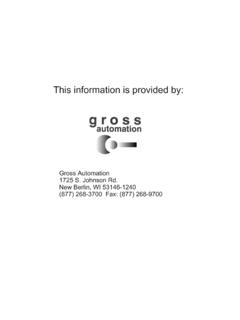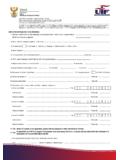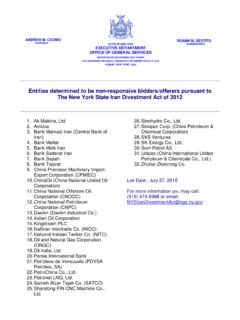Transcription of Assessment of slips safety information/literature …
1 Executive Health and safety Assessment of slips safety information / literature provided by flooring and footwear suppliers Prepared by the Health and safety Laboratory for the Health and safety Executive 2009 RR747 Research Report Executive Health and safety Assessment of slips safety information / literature provided by flooring and footwear suppliers Mr Mark Liddle Health and safety Laboratory Harpur Hill Buxton Derbyshire SK17 9JN Nearly 11,000 workers suffered serious injury as a result of a slip or trip in 2007. A key element of HSE s work to reduce slips and trips is to raise awareness of how slip risks can be controlled through the use of suitable flooring and footwear. Footwear suppliers use a variety of terms to describe their products, eg slip -resistant , anti- slip , improving grip performance etc, and these can often mislead customers. slip -resistant industrial footwear will normally have been tested according to European standards, but many manufacturers and suppliers do not give helpful additional information , such as the degree of slip resistance and the types of work environment for which their products are most suited.
2 For flooring , it is currently very difficult to make comparisons between products due to the number of tests used and specifications quoted. Where test data is provided , often very little explanation is given and the lay person could be easily confused or misled. HSE maintains that employers must be provided with clear and helpful information that will enable them to source footwear and flooring products which are suitable for their work environment. This report and the work it describes were funded by the Health and safety Executive (HSE). Its contents, including any opinions and/or conclusions expressed, are those of the authors alone and do not necessarily reflect HSE policy. HSE Books Crown copyright 2009 First published 2009 All rights reserved. No part of this publication may be reproduced, stored in a retrieval system, or transmitted in any form or by any means (electronic, mechanical, photocopying, recording or otherwise) without the prior written permission of the copyright owner.
3 Applications for reproduction should be made in writing to: Licensing Division, Her Majesty s Stationery Office, St Clements House, 2-16 Colegate, Norwich NR3 1BQ or by e-mail to ii CONTENTS EXECUTIVE SUMMARY .. V 1 2 RESULTS AND DISCUSSION ..2 Footwear flooring 3 4 FURTHER 5 6 REFERENCES AND FURTHER READING ..12 iii iv EXECUTIVE SUMMARY Objectives The aim of this project was to collect and assess the slips safety information / literature provided by flooring and footwear suppliers, to enable HSE to ascertain whether or not flooring and footwear suppliers are fulfilling their statutory duties, and to provide HSE with the opportunity to assess the impact of subsequent interventions in the field. A baseline Assessment of the workplace flooring and footwear products available in the market place in late 2008 was undertaken to: Determine the proportion of suppliers and manufacturers who supply slip resistance data for their products.
4 Determine the range of test methods that are being used to generate slip resistance data and assess the validity of the test data provided . Compare slip resistance data held and/or generated by HSL with data provided by manufacturers and suppliers to give an indication of the quality of the slip resistance data being supplied. Main Findings A review of promotional and technical literature provided by footwear and flooring manufacturers showed that improvements to the information could be made to help procurers select a product that will work well in their work environment. A significant proportion of flooring products (55%) did not make any reference to slip resistance or provide any test data. However, the majority (88%) of those that claimed to be slip resistant did have test data to support these claims. A significant proportion (16%) of flooring data provided by suppliers did not consist of numerical test data but rather the German DIN R and A/B/C classifications; these have very broad acceptance criteria and so may not give a precise indication of slip resistance.
5 Furthermore, 13% of data provided by flooring manufacturers was generated using other tests which, in the opinion of HSE, can provide misleading results in contaminated conditions. No indication of slip resistance was given for 47% of footwear products. Another 36% claimed to be slip resistant but did not provide any test data to substantiate the claims. Others claimed compliance with standard specifications rather than giving numerical data, which does not give a clear indication of the product s slip resistance. Furthermore, some of the standards that were quoted were no longer current and had been superseded some years earlier. It was noted that very few footwear or flooring suppliers offered advice on the suitability (or otherwise) of their products for various environments. Where advice was given, it was generally to recommend a product for a particular environment, seemingly without any evidence to do so, without stating the environments where the product was not suitable.
6 Where limitations of use were stipulated, they tended to be based on product durability rather than slip resistance, some floor manufacturers claimed products were not suitable for wet or outdoor environments on the basis that water would spoil the product rather than because it would become slippery when wet. v Unfortunately, due to the varied range of test methods used and, in many cases, the obscure data provided , the German DIN R classifications, it was very difficult to draw direct comparisons with HSL test results. However, it was noted that some footwear products, whose suppliers claimed that they were slip resistant without providing substantiation data, achieved poor results when tested using HSL s ramp test. vi 1 INTRODUCTION Nearly 11,000 workers suffered serious injury (RIDDOR reportable major injuries) as a result of a slip or trip in 2007 and reducing this injury toll is a priority for the HSE.
7 The slips and Trips programme is seeking to achieve a significant reduction in major accidents caused by slips and trips. A key element of the slips and Trips programme of work is to raise awareness of slips and trips issues; this includes how slip risks can be controlled through the use of suitable flooring and footwear. Footwear can play an important part in preventing slips and trips but selecting the most suitable slip resistant footwear for a particular environment and/or work activity can be very difficult. Footwear suppliers use a variety of terms to describe their products, slip resistant , anti- slip , improving grip performance etc. which can often mislead customers. slip resistant industrial footwear will normally have been tested for slip resistance according to BS EN 13287:2004 (amended in 2007). However, work carried out by HSL in 2006 to evaluate current test methods used to measure slip resistance, has shown that this test has a lenient pass threshold, raising concerns that this could give a false impression of the suitability of a product.
8 Many manufacturers and suppliers do not give additional information , such as the types of work environment for which their products are most suited (or not suited) although they do have a legal duty to provide accurate descriptions of their products to enable purchasers to understand the relevant safety features, slip resistance data. If the number of slip and trip accidents in workplace areas is to be reduced, then employers seeking to procure new flooring and footwear must be supplied with clear and helpful information that will enable them to source products which are suitable for their work environment. Marketing and technical information for a wide range of flooring and footwear was collected to assess the quality of information provided by suppliers. information sources included: manufacturers websites, suppliers websites, catalogues, brochures, and trade shows.
9 Suppliers were also contacted to request information regarding the slip resistance of their products. The information and materials collected were examined to: Determine the proportion of suppliers and manufacturers who supply slip resistance data for their products. Determine the range of test methods that are being used to generate slip resistance data and assess the validity of the test data provided . Compare slip resistance data held and/or generated by HSL with data provided by manufacturers and suppliers to give an indication of the quality of the slip resistance data being supplied. 1 2 RESULTS AND DISCUSSION FOOTWEAR information In total, the literature pertaining to 1304 different styles and 55 different trade names of safety footwear was evaluated. Of the 1304 styles surveyed, 685 (53%) claimed to be slip resistant. Of this 53%, 183 (27%) claimed compliance with slip resistance specifications; 65 (9%) had test data in support of these claims and a further 147 (21%) had data available on request.
10 A breakdown of the type of information provided for each style of footwear included in our survey is shown in figure 1. 47% 36% 5% 11% slip resistance not sp ecified slip resistant / no data available slip resistant / data included in catalogue or on website slip resistant / data available on request Figure 1: Graphical summary of the slip resistance claims being made by suppliers, and the information they provide about their footwear. A review of the test data being quoted by suppliers showed that the majority of it was generated using tests known to have a lenient pass threshold. Data generated by HSE s preferred test (the HSL ramp test, HSL-PS-SOP12), was quoted for 26 styles. In addition to these, HSL has been employed to conduct ramp testing on other styles included in this study. However, where no details have been published in the suppliers promotional literature or on websites, these have not been included in our summation.
















